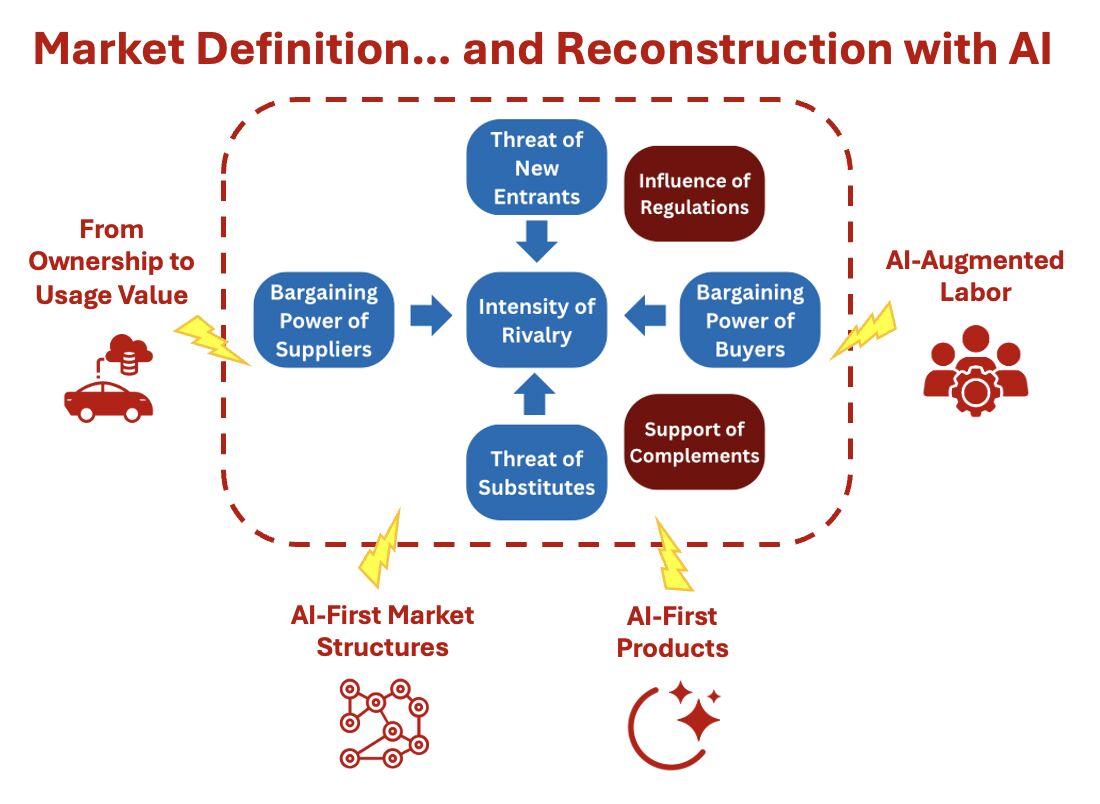Are you familiar with Porter’s Five Forces framework, a staple in MBA strategy courses? While it clarifies who can extract the most profit in an industry, it has several limitations: it presents a static view of competition, overlooks forces such as complements and regulations, and most critically, assumes that the market being analyzed is clearly defined. These issues become even more pronounced in the age of AI.
AI is not merely disrupting markets—it is reconstructing them. Building on earlier technological shifts that digitized existing structures, AI is reshaping how value is created, distributed, and captured. Here are four ways in which AI is fundamentally transforming market dynamics:
1. From Ownership to Usage Value
AI is shifting the focus from selling products to delivering services. This shift is evident in models like car sharing and robotaxis, where value lies in usage rather than ownership. Monetization evolves from fixed pricing to dynamic, AI-personalized value capture. Hybrid models are also emerging, such as owning an asset while renting it out through a platform network.
2. AI-First Market Structures
Industries like banking and insurance, once reliant on manual underwriting and fixed pricing, are being restructured by AI. Platforms like Uniswap leverage blockchain and smart contracts to automate market making and decentralize trading. Companies like Ant Group use AI for real-time risk pricing and instant lending. In these models, growth is software-driven rather than labor-driven, with competitive advantage increasingly tied to self-improving AI systems.
3. AI-First Products: from One-Time Sales to Ongoing Value Delivery
Simulation environments powered by AI and synthetic data enable the rapid testing of new possibilities, from aircraft designs to drug interactions and to precision agriculture. The capabilities of these products can redefine expectations or even create new categories. As importantly, the products continue improving their features post-launch through over the air updates.
4. Differentiating through AI-Augmented Labor
AI is augmenting human labor by accelerating task execution and enhancing decision quality, at scale. Software development and medicine are being reshaped by AI-powered coding assistants, low-code platforms and diagnostic tools. Innovation loops get faster. As a result, roles such as engineers and strategists become more central, while organizational layers flatten and middle management roles decline. Many AI-startups limit their workforce to 150 employees for optimal cultural clarity. In short, AI-Augmented labor has the potential to reinforce one’s differentiation.
In formulating strategy, we must avoid the trap of assuming static market boundaries. Instead, we should rethink markets as social constructs organized around customer needs – needs that AI enables us to meet in entirely new ways.
hashtag#5Forces hashtag#AI hashtag#Marketstructure

In the Age of AI: From Porter’s Five Forces to Constructing Markets
•

Leave a Reply